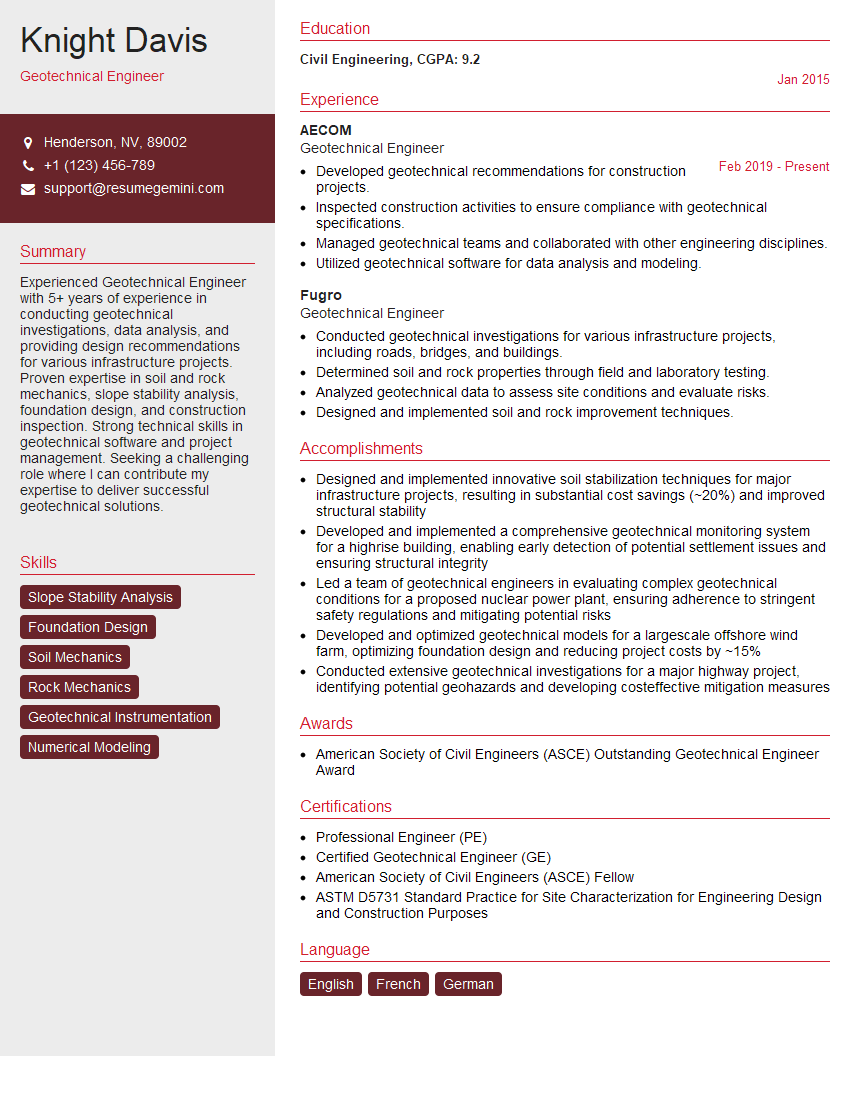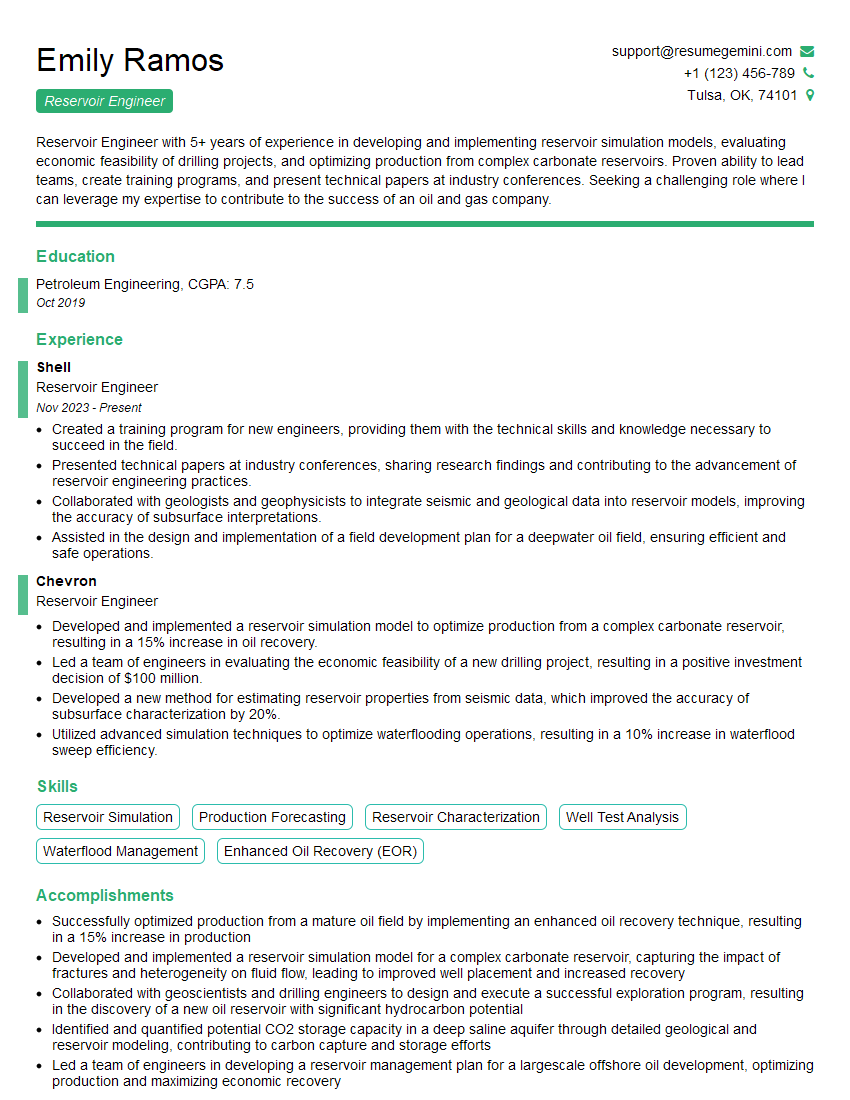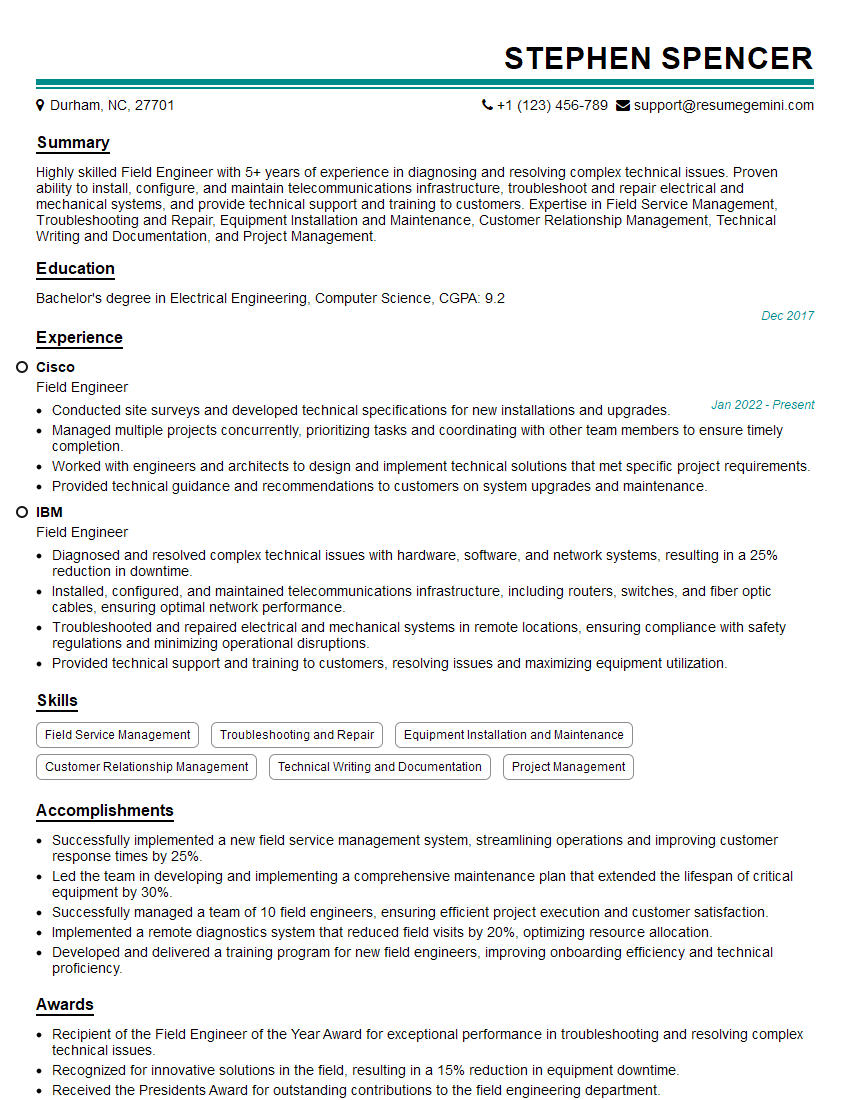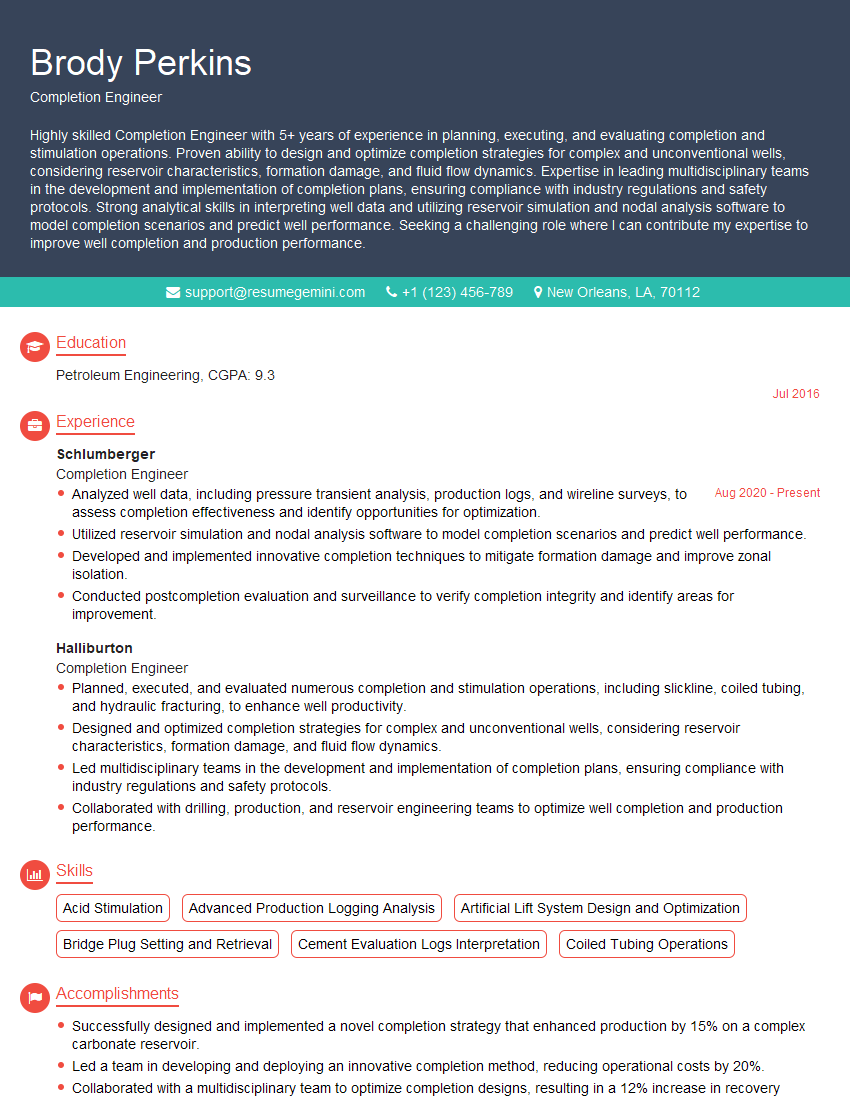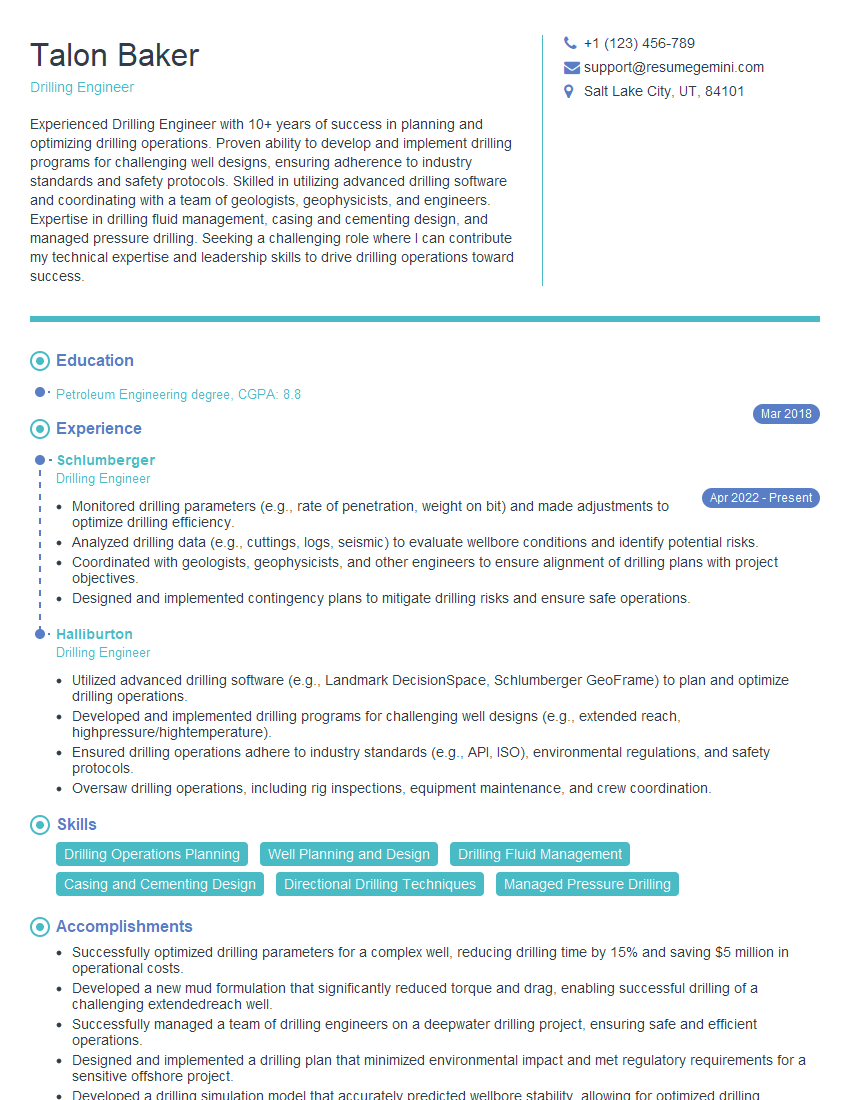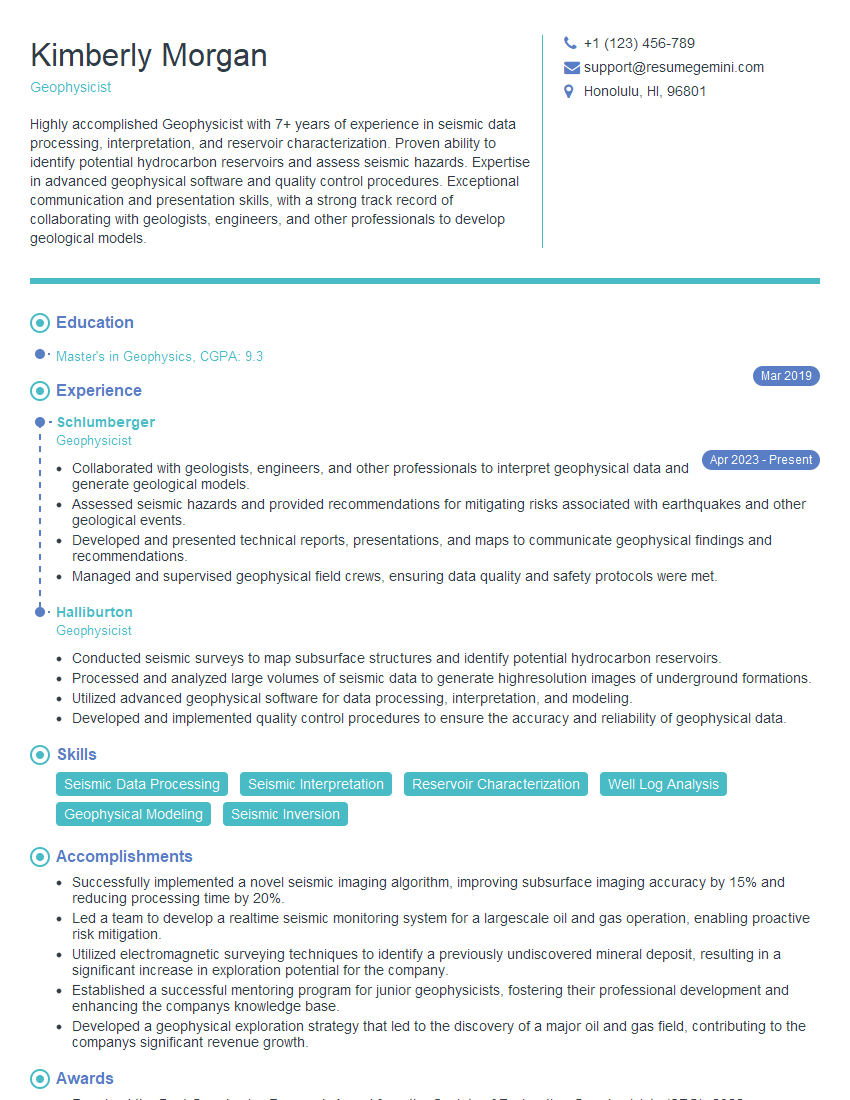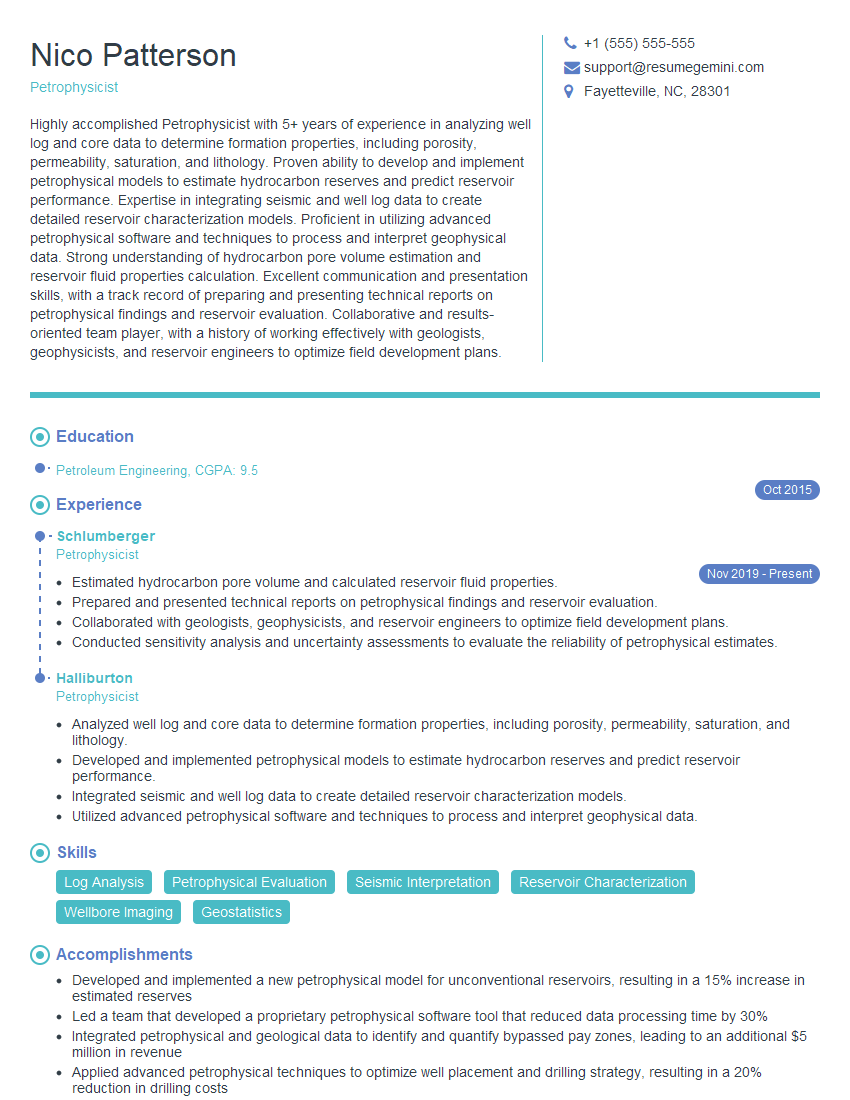The thought of an interview can be nerve-wracking, but the right preparation can make all the difference. Explore this comprehensive guide to Porosity and Permeability Analysis interview questions and gain the confidence you need to showcase your abilities and secure the role.
Questions Asked in Porosity and Permeability Analysis Interview
Q 1. Define porosity and permeability. Explain their significance in reservoir engineering.
Porosity is the void space within a rock or sediment, expressed as a percentage of the total volume. Think of it like the amount of empty space in a sponge. Permeability, on the other hand, measures how easily fluids (like oil, gas, or water) can flow through that interconnected pore space. It’s like how easily water flows through that same sponge – a sponge with large, connected pores will have high permeability.
In reservoir engineering, both porosity and permeability are crucial for determining a reservoir’s hydrocarbon storage capacity and production potential. High porosity indicates a large storage volume, while high permeability ensures that hydrocarbons can be readily extracted. A reservoir with high porosity but low permeability might contain significant hydrocarbons but be difficult to produce from, making it economically less viable.
Q 2. Explain different types of porosity (e.g., intergranular, vuggy, fracture).
Porosity comes in various forms, each impacting fluid flow differently:
- Intergranular Porosity: This is the most common type, representing the pore space between individual grains of sediment, like the spaces between sand grains in a sandstone reservoir. Imagine a perfectly packed box of marbles; the spaces between the marbles represent intergranular porosity.
- Vuggy Porosity: This involves large cavities or vugs within the rock matrix, often formed by dissolution of minerals. Think of Swiss cheese; the holes are analogous to vugs.
- Fracture Porosity: This type of porosity arises from cracks or fractures in the rock, which can significantly improve permeability even if the primary porosity (intergranular or vuggy) is low. Imagine a solid block of rock with cracks running through it; the cracks create pathways for fluids.
Understanding the different types of porosity is essential because it influences fluid flow characteristics and ultimately the reservoir’s productivity.
Q 3. Describe various methods for measuring porosity (e.g., lab methods, log-derived methods).
Porosity can be measured using various methods:
- Laboratory Methods: These involve direct measurement on core samples. The most common is the Boyle’s Law method, where the core sample’s volume is measured under different pressures, allowing calculation of the pore volume and thus porosity. Other methods include helium porosimetry and mercury injection capillary pressure.
- Log-Derived Methods: These methods utilize data from well logs (measurements taken while drilling a well). Density, neutron, and sonic logs can indirectly estimate porosity by measuring rock properties related to pore volume. For instance, a neutron log measures hydrogen content, which is high in porous, fluid-saturated rocks. These methods provide continuous porosity profiles downhole, covering a larger volume than core analysis.
The choice of method depends on factors like data availability, cost, and desired accuracy. Often, a combination of both lab and log-derived methods provides the most comprehensive understanding of reservoir porosity.
Q 4. Discuss the relationship between porosity and permeability.
Porosity and permeability are related but not directly proportional. While high porosity *can* lead to high permeability, it’s not guaranteed. Think of two sponges: one with many small, unconnected pores, and another with fewer but large, interconnected pores. The first sponge might have higher porosity but lower permeability because the fluids can’t easily flow through the isolated pores. The second sponge may have lower porosity but higher permeability because the interconnected pores provide easy flow paths.
The connectivity and size distribution of the pore network significantly influence permeability. A well-connected pore network allows for easier fluid movement, even with moderate porosity.
Q 5. What is absolute permeability? How is it different from effective permeability?
Absolute permeability refers to the ability of a rock to transmit a single fluid (like water, oil, or gas) when the pores are 100% saturated with that fluid. It’s a fundamental property of the rock, independent of the presence of other fluids. It’s measured under laboratory conditions with a single fluid filling the pore space.
Effective permeability, on the other hand, describes the permeability of a rock to a specific fluid when multiple fluids (e.g., oil and water) are present. It represents the ease with which that specific fluid can flow through the rock in the presence of other fluids. This is highly dependent on the fluid saturation and the relative wettability of the rock.
In essence, absolute permeability is a rock property, whereas effective permeability is influenced by both rock properties and fluid properties.
Q 6. Explain the concept of relative permeability and its importance in reservoir simulation.
Relative permeability is the ratio of effective permeability to absolute permeability for a given fluid at a specific saturation. It expresses the fractional reduction in permeability to a fluid due to the presence of other immiscible fluids. For example, the relative permeability of oil will decrease as water saturation increases, reflecting the reduced ability of oil to flow through the rock as water occupies more pore space.
Relative permeability is crucial in reservoir simulation because it directly affects the displacement efficiency of hydrocarbons during production. Accurate relative permeability curves are essential for predicting oil and gas recovery rates and optimizing production strategies. These curves are often determined experimentally using coreflood experiments.
Q 7. How do different pore geometries affect permeability?
Pore geometry significantly impacts permeability. Factors like pore size distribution, shape, and connectivity all play a crucial role:
- Pore size: Larger pores generally facilitate higher permeability, as there is less resistance to fluid flow.
- Pore shape: Round, interconnected pores allow for easier flow compared to elongated or irregular pores, which can create tortuous flow paths and hinder permeability.
- Pore connectivity: Well-connected pores create a continuous pathway for fluid flow, leading to higher permeability. Poor connectivity, as in a rock with isolated pores, restricts fluid movement and results in low permeability.
- Tortuosity: This refers to the complexity of the flow path, with highly tortuous pathways reducing permeability.
Complex pore geometries require sophisticated techniques like image analysis and pore-network modeling for accurate permeability prediction.
Q 8. Describe different laboratory techniques used to measure permeability.
Measuring permeability in the lab involves determining how easily fluids can flow through a rock sample. Several techniques exist, each with its strengths and weaknesses.
- Steady-State Method: This classic method involves applying a constant pressure difference across a core sample saturated with a fluid (often water or oil). The flow rate is measured, and Darcy’s Law (
Q = -kA(dP/dL), where Q is flow rate, k is permeability, A is cross-sectional area, dP is pressure difference, and dL is length) is used to calculate permeability. It’s accurate but time-consuming. - Unsteady-State Method (Pulse Decay): This method is faster. A pulse of fluid is injected into the core, and the pressure drop over time is monitored. Permeability is then calculated from the pressure decay curve. This method is useful for low-permeability samples.
- Klinkenberg Effect Correction: At low pressures, gas permeability measurements can be affected by the Klinkenberg effect – gas slippage along pore walls. Corrections are applied to extrapolate to true permeability at higher pressures.
- Permeameter Types: Different permeameters exist, ranging from simple, single-phase setups to sophisticated multiphase systems capable of measuring relative permeability (how easily different fluids, like oil and water, flow through the rock simultaneously).
The choice of method depends on factors such as the rock type, expected permeability range, available equipment, and time constraints.
Q 9. What are the limitations of using core samples for permeability determination?
While core samples provide invaluable data for permeability determination, several limitations exist:
- Representativeness: A single core sample may not accurately represent the entire reservoir’s heterogeneity. Reservoirs are complex, with variations in porosity and permeability across different locations.
- Damage During Extraction: The process of extracting core samples can damage the rock, altering its original permeability. Fractures may be induced, or pore spaces may collapse.
- Scale Effects: Core samples are typically small, representing a limited volume of the reservoir. Permeability measured on a small scale may not accurately reflect large-scale reservoir behavior.
- Cost and Time: Obtaining and analyzing core samples is expensive and time-consuming. It’s not always feasible to obtain a sufficient number of cores to adequately characterize a reservoir.
- Depth Limitations: Core retrieval becomes increasingly challenging at greater depths.
Therefore, it’s crucial to understand these limitations and use core data in conjunction with other techniques (like well logs) for a more comprehensive reservoir characterization.
Q 10. Explain how well logs are used to estimate porosity and permeability.
Well logs are continuous measurements taken while a logging tool is lowered into a borehole. They provide indirect estimations of porosity and permeability across the entire well, offering a broader perspective than core samples alone. Porosity is directly estimated from certain logs (discussed in the next answer), while permeability is indirectly inferred through empirical correlations with porosity and other log parameters. These correlations are often developed and calibrated using core data. For example, a higher porosity generally suggests a higher permeability (but not always, due to pore throat size and connectivity).
The process often involves:
- Log Acquisition: Various types of well logs (density, neutron, sonic) are acquired.
- Data Processing: The raw log data is processed to correct for tool effects and environmental factors.
- Porosity Calculation: Porosity is calculated from the relevant logs.
- Permeability Estimation: Permeability is estimated using empirical correlations calibrated on core data or through more sophisticated techniques, such as using the log-derived porosity and the formation factor.
- Validation: The estimated porosity and permeability are validated against core data where available.
This integrated approach improves the overall reservoir description and reduces uncertainty compared to relying solely on core data.
Q 11. Discuss the various log types used for porosity and permeability estimation (e.g., density, neutron, sonic).
Several log types contribute to porosity and permeability estimation:
- Density Log: Measures the bulk density of the formation. By knowing the matrix density and fluid density, porosity can be calculated using the density porosity equation. This log is less sensitive to pore fluid type.
- Neutron Log: Measures the hydrogen index of the formation. Since hydrogen is abundant in water and hydrocarbons, this log is primarily sensitive to porosity. However, it’s more sensitive to fluid type than the density log. Different neutron tools (e.g., compensated neutron, pulsed neutron) offer improved accuracy and the ability to differentiate between gas and liquid.
- Sonic Log: Measures the velocity of acoustic waves through the formation. Porosity is indirectly related to the velocity, with higher porosity generally leading to lower velocity. The sonic log is also sensitive to fracturing and lithology.
- Formation Resistivity Log: Although primarily used to measure the resistivity of the formation (related to fluid saturation), it can indirectly influence permeability estimation, as high permeability generally leads to lower resistivity.
Combining these logs helps reduce uncertainties and improves the reliability of porosity and permeability estimations. For instance, cross-plots of density and neutron logs can identify gas zones, while the sonic log provides insights into formation compaction and fracturing.
Q 12. How do you handle uncertainty in porosity and permeability estimations?
Uncertainty in porosity and permeability estimations is inherent due to the limitations of measurement techniques and the heterogeneity of subsurface formations. Handling this uncertainty requires a probabilistic approach:
- Statistical Analysis: Analyzing the distribution of porosity and permeability values from core samples and logs allows for calculation of mean values, standard deviations, and confidence intervals.
- Monte Carlo Simulation: This technique can generate numerous realizations of the reservoir model, each reflecting possible variations in porosity and permeability. This helps understand the range of possible outcomes and the associated risks.
- Geostatistical Methods: Techniques like kriging are used to interpolate porosity and permeability values between data points, incorporating spatial correlation and uncertainty.
- Sensitivity Analysis: Identifying which input parameters (e.g., log calibration, core analysis results) most significantly impact the uncertainty in permeability estimation helps focus efforts on improving those measurements.
- Multiple Data Integration: Combining data from different sources (core, logs, seismic) minimizes the reliance on any single data source, thereby reducing overall uncertainty.
Transparency about uncertainty in estimations is crucial for making informed reservoir management decisions.
Q 13. Explain the concept of capillary pressure and its effect on fluid flow.
Capillary pressure is the pressure difference across the interface between two immiscible fluids (like oil and water) in a porous medium. It’s a function of the pore size distribution and the interfacial tension between the fluids. In smaller pores, the capillary pressure is higher, leading to a higher pressure in the non-wetting phase (e.g., oil) compared to the wetting phase (e.g., water). This pressure difference significantly impacts fluid flow.
Consider an oil-water system: In the reservoir, capillary pressure acts to trap water in smaller pores while oil preferentially occupies larger pores. As oil production progresses, this capillary pressure can hinder oil recovery, making it increasingly difficult to extract oil from the smaller pores. Understanding capillary pressure curves, which show the relationship between capillary pressure and water saturation, is crucial for predicting reservoir performance and optimizing production strategies. Techniques like centrifuge and porous plate methods are used to measure capillary pressure in the laboratory.
Q 14. How does temperature and pressure affect porosity and permeability?
Temperature and pressure significantly influence both porosity and permeability:
- Temperature Effects: Increased temperature generally leads to thermal expansion of the pore fluids. This effect is typically minor compared to pressure effects, and is often neglected, unless significant temperature changes are anticipated.
- Pressure Effects: Pressure changes have a more pronounced effect. Increased pressure can cause compaction, reducing porosity and potentially permeability. This effect is particularly significant in unconsolidated or poorly cemented formations. Conversely, reducing pressure (e.g., during production) can cause the rock matrix to expand slightly, potentially increasing porosity and permeability (though usually to a smaller degree). The extent of these changes depends on the rock’s mechanical properties and its stress history.
For example, during reservoir depletion, the reduction in pore pressure can lead to compaction and a decrease in permeability, impacting the overall production rate. Accurate reservoir simulation models must account for these temperature and pressure effects to provide reliable predictions of reservoir behavior.
Q 15. Describe the concept of irreducible water saturation.
Irreducible water saturation (Swir) represents the minimum amount of water that remains trapped within the pore spaces of a rock even after extensive displacement by another fluid, such as oil or gas. Think of it like water clinging stubbornly to the tiny grains of sand in a beach – you can’t simply pour it all out. This water is held in place by capillary forces and surface tension. It’s crucial for reservoir engineers because it directly affects the amount of hydrocarbons that can be produced from a reservoir. A higher Swir means less space available for oil or gas, reducing the overall recoverable reserves.
For example, if a reservoir rock has 20% porosity and an Swir of 20%, then only 80% of the pore space is available to be filled by hydrocarbons. This 20% irreducible water saturation is not producible, despite being within the pore space.
Career Expert Tips:
- Ace those interviews! Prepare effectively by reviewing the Top 50 Most Common Interview Questions on ResumeGemini.
- Navigate your job search with confidence! Explore a wide range of Career Tips on ResumeGemini. Learn about common challenges and recommendations to overcome them.
- Craft the perfect resume! Master the Art of Resume Writing with ResumeGemini’s guide. Showcase your unique qualifications and achievements effectively.
- Don’t miss out on holiday savings! Build your dream resume with ResumeGemini’s ATS optimized templates.
Q 16. What are the key factors that influence the accuracy of porosity and permeability estimations?
The accuracy of porosity and permeability estimations is influenced by a multitude of factors, which can be broadly categorized into:
- Sample Quality and Representativeness: The core samples used for analysis must be representative of the entire reservoir. Heterogeneity in the reservoir can lead to significant variations in porosity and permeability. Poorly preserved or damaged cores will yield inaccurate results.
- Measurement Techniques: Different methods exist for measuring porosity and permeability (e.g., Helium porosimetry, nitrogen gas adsorption, steady-state permeability, pulse decay permeability). Each method has its own limitations and assumptions; selecting the appropriate technique is crucial. The precision and accuracy of the equipment employed also play a significant role.
- Formation Properties: Factors such as grain size distribution, cementation, clay content, and the presence of fractures all impact porosity and permeability. For instance, a well-cemented sandstone will exhibit lower permeability than a poorly cemented one.
- Fluid Properties: The type and properties of the fluids present in the pore spaces (e.g., oil, water, gas) influence permeability measurements, particularly in relative permeability determinations. The viscosity of the fluid affects the flow rate and thus the apparent permeability.
- Data Processing and Interpretation: Errors can arise during data processing and interpretation. For example, the use of inappropriate correlations or the misinterpretation of log data can lead to inaccurate estimations.
It’s vital to consider all these factors to ensure reliable results. A careful selection of analysis techniques and a thorough understanding of the formation’s geological characteristics are critical.
Q 17. Explain the impact of formation damage on porosity and permeability measurements.
Formation damage refers to any alteration of reservoir rock properties near the wellbore during drilling, completion, or production operations. This can significantly affect porosity and permeability measurements, leading to underestimation of reservoir potential. Damage can occur due to various factors such as:
- Drilling fluids invasion: The invasion of drilling mud into the formation can block pore throats, reducing permeability.
- Fracture creation and proppant embedment: Hydraulic fracturing can create fractures, but improper proppant placement may hinder permeability.
- Chemical reactions: Reactions between drilling fluids and formation minerals can alter the rock’s structure, affecting both porosity and permeability.
- Particle migration: Fine particles from the formation or drilling mud can migrate into the pore spaces, causing permeability reduction.
The impact on porosity measurements might be less direct, but the reduction in permeability is often significant. This can result in lower production rates than initially predicted, highlighting the importance of minimizing formation damage during well operations.
For example, imagine a sandstone reservoir with initially high permeability. If drilling mud invades and clogs the pore throats, the measured permeability near the wellbore will be significantly lower than the true reservoir permeability, leading to an underestimation of the reservoir’s productive capacity.
Q 18. How do you interpret the results of a core analysis report?
Interpreting a core analysis report requires a systematic approach. I start by examining the following:
- Porosity data: Analyze the different types of porosity (total, effective, etc.) to understand the pore space distribution. I would look for trends and variations across different depths and locations. Any anomalies, like unusually high or low porosity values, should be investigated further.
- Permeability data: Examine the absolute permeability data, assessing variations with depth and location. Pay close attention to the relationship between porosity and permeability. A high porosity doesn’t automatically mean high permeability. Cementation and other factors play a crucial role.
- Capillary pressure curves: These curves provide insights into the fluid distribution within the pores and help determine irreducible water saturation and relative permeability.
- Grain size distribution: Analysis of grain size reveals information about the pore size distribution, impacting both porosity and permeability.
- Mineral composition: This helps understand the rock type and its potential impact on porosity and permeability. Clay minerals, for instance, can significantly reduce permeability.
- Visual descriptions: The report should include visual descriptions of the core samples, such as color, texture, and any visible fractures or other features.
I use this information to build a comprehensive understanding of the reservoir’s petrophysical properties. Comparing these results with other data, such as well logs, is crucial for confirming and validating the findings.
Q 19. How would you assess the quality of porosity and permeability data?
Assessing the quality of porosity and permeability data involves several steps:
- Data Validation: Check for internal consistency within the dataset. Are there any outliers or unusual trends that require further investigation? Compare data from different analytical techniques to ensure consistency.
- Comparison with other data: Compare core analysis data with well log data, image logs, and other available geological information. Discrepancies should be carefully reviewed and explained.
- Uncertainty assessment: Quantify the uncertainty associated with the measurements. Consider the errors associated with the analytical methods and the representativeness of the core samples.
- Review of methodology: Evaluate the appropriateness of the methods used for data acquisition and analysis. Were the correct procedures followed? Were the equipment and calibration adequate?
- Laboratory quality control: Verify if the laboratory performing the analysis adheres to industry standards and quality control procedures.
By applying these steps, we can gain confidence in the reliability and accuracy of the data, ensuring that the subsequent reservoir engineering calculations are based on sound information.
Q 20. What software packages are you familiar with for analyzing porosity and permeability data?
I am proficient in several software packages used for analyzing porosity and permeability data, including:
- Petrel:
- RMS (Kingdom):
- IP (Interactive Petrophysics):
- Excel (with add-ins):
My expertise extends to using these platforms for data visualization, interpretation, and modeling. I am comfortable manipulating and analyzing large datasets, running correlations, and generating reports.
Q 21. Describe your experience in interpreting porosity and permeability data in different reservoir types (e.g., sandstone, carbonate).
My experience encompasses interpreting porosity and permeability data in various reservoir types. Sandstone reservoirs, for example, often exhibit a relatively simple pore structure, making the correlation between porosity and permeability relatively straightforward, though still influenced by factors like cementation and clay content. In contrast, carbonate reservoirs can be much more complex. They often have a wide range of pore types and sizes, including intergranular, intragranular, moldic, and fracture porosity, leading to more challenging interpretations. Fractures in carbonates play a significant role, often dominating permeability despite relatively low total porosity.
I’ve worked on projects involving both types of reservoirs, adapting my approach depending on the specific geological setting. For instance, in analyzing a fractured carbonate, I might employ advanced imaging techniques and specialized software to characterize the fracture network and its contribution to permeability. The interpretation in sandstones often relies on simpler techniques, focusing on the relationship between grain size, cementation, and permeability.
My experience also extends to unconventional reservoirs, such as shale gas plays, where porosity and permeability are particularly low and measurements require specialized techniques and data interpretation. The understanding of the pore network and its intricate nature is crucial in such scenarios. Ultimately, my approach is to understand the unique characteristics of each reservoir type and apply the most suitable analytical methods for achieving accurate and reliable results.
Q 22. Explain your understanding of Darcy’s Law and its applications.
Darcy’s Law is the foundational equation in hydrogeology and reservoir engineering that describes the flow of fluids through porous media. It states that the flow rate (Q) is proportional to the hydraulic gradient (Δh/L) and the permeability (k) of the medium, and inversely proportional to the fluid viscosity (μ). Think of it like water flowing through sand: the steeper the slope (hydraulic gradient), the more water flows; the coarser the sand (higher permeability), the faster the flow; and the thicker the water (higher viscosity), the slower the flow.
Mathematically, it’s expressed as: Q = -kA(Δh/L) / μ, where A is the cross-sectional area. The negative sign indicates flow from high to low pressure.
Applications of Darcy’s Law are widespread, including:
- Reservoir Simulation: Predicting oil and gas production rates from underground reservoirs.
- Groundwater Modeling: Assessing groundwater recharge and discharge, predicting contaminant transport.
- Environmental Remediation: Designing strategies for cleaning up contaminated sites.
- Civil Engineering: Analyzing seepage under dams and foundations.
Essentially, Darcy’s Law allows us to quantify and predict fluid movement in porous media, which is crucial in many applications.
Q 23. How would you use porosity and permeability data in reservoir simulation studies?
Porosity (φ) and permeability (k) are fundamental reservoir properties that directly influence fluid flow and storage capacity. In reservoir simulation studies, we use this data to create a numerical model representing the reservoir’s behavior.
Porosity data, representing the void space within the rock, informs the amount of hydrocarbons a reservoir can hold. Permeability data, describing the interconnectedness of the pores and the ease of fluid flow, dictates the rate at which these hydrocarbons can be produced. We integrate this data into reservoir simulation software using various techniques:
- Grid-block assignment: We assign average porosity and permeability values to individual grid blocks in a numerical model of the reservoir.
- Stochastic modeling: If data is sparse, we use geostatistical methods (like kriging) to estimate porosity and permeability distributions throughout the reservoir, accounting for uncertainty.
- History matching: We calibrate the model by adjusting porosity and permeability values to match historical production data, refining the representation of the reservoir.
This integrated approach allows us to predict future production, optimize well placement and drilling strategies, and manage reservoir pressure effectively. For instance, areas with high porosity and high permeability are prime targets for initial production.
Q 24. Explain the concept of heterogeneity in reservoir properties and its implications.
Reservoir heterogeneity refers to the variations in reservoir properties (porosity, permeability, saturation, etc.) within a reservoir. Imagine a sponge: a perfectly homogeneous sponge would have uniform pore sizes and water absorption throughout. A heterogeneous sponge, however, would have areas with larger pores, smaller pores, and perhaps even some solid parts, leading to uneven water absorption. Similarly, a heterogeneous reservoir exhibits inconsistent properties throughout its volume.
Implications of heterogeneity are significant:
- Uneven fluid flow: Fluids tend to preferentially flow through high-permeability zones, leaving hydrocarbons trapped in less permeable areas.
- Complex sweep efficiency: Water or gas injection strategies can be less effective due to variations in permeability; some areas might be swept effectively, while others remain untouched.
- Challenges in reservoir management: Accurate prediction of production becomes more difficult and requires sophisticated modeling techniques.
- Increased uncertainty in reserve estimations: Heterogeneity makes it challenging to accurately estimate the total amount of hydrocarbons in place.
Understanding and characterizing heterogeneity is crucial for successful reservoir management.
Q 25. Discuss your experience with different techniques used to characterize reservoir heterogeneity.
Characterizing reservoir heterogeneity involves integrating data from various sources and applying advanced analytical techniques. My experience includes using:
- Core Analysis: Direct measurement of porosity and permeability on core samples from wells. This provides high-resolution data but is limited to the wellbore locations.
- Well Log Analysis: Using wireline logging tools to measure properties in the subsurface, providing continuous data along the wellbore. I’ve used various logs like porosity logs (neutron, density), permeability logs (NMR), and resistivity logs.
- Seismic Data: Analyzing seismic reflections to infer reservoir properties. I’ve worked with seismic attributes to identify potential areas of high and low permeability, providing a large-scale view of heterogeneity.
- Geostatistical Methods: Utilizing kriging, sequential Gaussian simulation, or other geostatistical techniques to interpolate data from wells and create a 3D model of reservoir properties, handling spatial uncertainties.
- Production Data Analysis: Analyzing historical production data to infer reservoir properties indirectly. Pressure buildup and decline curves can provide insights into reservoir permeability and connectivity.
Combining these techniques provides a comprehensive understanding of reservoir heterogeneity, enabling more robust reservoir models and optimized field development plans. For instance, in one project, integrating seismic data with well log data significantly improved our reservoir model, leading to a more accurate prediction of oil recovery.
Q 26. How would you identify and resolve inconsistencies in porosity and permeability data?
Inconsistencies in porosity and permeability data are common and can arise from various sources, including measurement errors, different analytical techniques, or inherent reservoir heterogeneity. Identifying and resolving these inconsistencies is crucial for reliable reservoir modeling.
Identification: I use a multi-pronged approach:
- Data Validation: Check for outliers and unrealistic values. This includes comparing results from different data sources and using basic statistical analysis.
- Cross-plotting: Creating cross-plots of porosity versus permeability, identifying unusual trends or data points that deviate significantly from expected relationships.
- Spatial analysis: Examining the spatial distribution of porosity and permeability values to identify inconsistencies and potential errors.
Resolution: After identification, I address inconsistencies by:
- Data cleaning: Removing obvious outliers or correcting errors through data reconciliation.
- Data transformation: Applying transformations (e.g., log transformation) to normalize data and improve the relationship between porosity and permeability.
- Geostatistical methods: Using geostatistical techniques to smooth out inconsistencies while respecting the overall spatial variability of the reservoir.
- Expert judgment: Incorporating geological knowledge and interpretation to resolve inconsistencies.
A careful, iterative approach is often needed to ensure data consistency and accuracy.
Q 27. Describe a situation where you had to overcome a challenge related to porosity and permeability analysis.
In a recent project involving a tight gas reservoir, we faced a significant challenge. Core analysis indicated extremely low permeability, suggesting poor production potential. However, well test data showed surprisingly high gas flow rates. This discrepancy presented a major hurdle in predicting future production.
After thorough investigation, we realized the core samples did not accurately represent the in-situ reservoir conditions due to stress relief during sample extraction. The tight rock matrix underwent fracturing during the well stimulation process, significantly improving permeability. We overcame this by integrating micro-seismic data from the stimulation process, which mapped the induced fractures. This information allowed us to update our reservoir model, incorporating the enhanced permeability in the fractured zones and resulting in much more realistic production forecasts.
Q 28. How do you ensure the accuracy and reliability of porosity and permeability data used in decision-making?
Ensuring accuracy and reliability of porosity and permeability data is paramount for informed decision-making. My approach involves several key steps:
- Quality control of data acquisition: Implementing rigorous quality control procedures during core analysis, well logging, and data processing. This includes regular calibration checks and data validation.
- Data redundancy and cross-validation: Using multiple independent methods to measure porosity and permeability (e.g., core analysis, well logs, and production data) and comparing the results to identify inconsistencies and potential errors.
- Uncertainty quantification: Recognizing and quantifying uncertainty associated with measurements and estimations. This includes error bars in data representation and probabilistic modeling.
- Data integration and interpretation: Integrating data from various sources and utilizing geological understanding to interpret the data and resolve inconsistencies.
- Sensitivity analysis: Performing sensitivity analysis on reservoir models to assess the impact of variations in porosity and permeability data on production forecasts.
By following these steps, we can build more robust and reliable reservoir models and minimize the risk associated with decisions based on inaccurate or unreliable data.
Key Topics to Learn for Porosity and Permeability Analysis Interview
- Fundamentals of Porosity: Definition, types (total, effective, interconnected), measurement techniques (e.g., Boyle’s Law, Helium porosimetry), and their impact on reservoir characterization.
- Fundamentals of Permeability: Definition, Darcy’s Law, absolute and effective permeability, factors influencing permeability (e.g., pore size distribution, pore geometry, fluid saturation), and its role in fluid flow prediction.
- Capillary Pressure and its relationship to Porosity and Permeability: Understanding capillary pressure curves, their implications for fluid saturation and relative permeability, and how these concepts influence reservoir simulation.
- Practical Applications: Reservoir engineering (e.g., reserve estimation, production forecasting), enhanced oil recovery techniques (EOR), geological modeling, and well testing analysis.
- Data Analysis and Interpretation: Working with core data, well logs (e.g., porosity logs, permeability logs), and interpreting results to build a comprehensive understanding of reservoir properties. This includes understanding error analysis and limitations of various measurement techniques.
- Numerical Methods and Simulation: Familiarity with software used for reservoir simulation and the theoretical basis behind these simulations (e.g., Finite Difference, Finite Element methods). Understanding the input parameters and interpreting the output.
- Advanced Concepts: Heterogeneity in reservoir properties, fractal dimensions, and the impact of pore-scale physics on macroscopic behavior. This also includes understanding different rock types and their unique characteristics regarding porosity and permeability.
Next Steps
Mastering Porosity and Permeability Analysis is crucial for a successful career in the energy sector, opening doors to exciting roles in reservoir engineering, geological modeling, and related fields. A strong understanding of these concepts will significantly enhance your problem-solving abilities and technical expertise. To maximize your job prospects, creating a compelling and ATS-friendly resume is essential. ResumeGemini is a trusted resource that can help you build a professional resume that highlights your skills and experience effectively. Examples of resumes tailored to Porosity and Permeability Analysis are available to help you create a stand-out application.
Explore more articles
Users Rating of Our Blogs
Share Your Experience
We value your feedback! Please rate our content and share your thoughts (optional).
What Readers Say About Our Blog
Hi, I have something for you and recorded a quick Loom video to show the kind of value I can bring to you.
Even if we don’t work together, I’m confident you’ll take away something valuable and learn a few new ideas.
Here’s the link: https://bit.ly/loom-video-daniel
Would love your thoughts after watching!
– Daniel
This was kind of a unique content I found around the specialized skills. Very helpful questions and good detailed answers.
Very Helpful blog, thank you Interviewgemini team.


